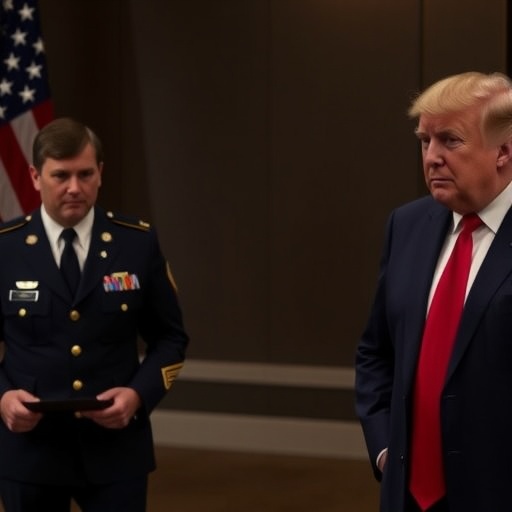Trump Shutdown Hits CDC Hard with 1,300 Layoffs While ICE and Military Funding Flows Freely
In a move that’s sending shockwaves through the public health community, the Trump administration has slashed roughly one-quarter of the Centers for Disease Control and Prevention’s (CDC) workforce in just eight months, culminating in 1,300 termination notices delivered in early October. As the federal government shutdown drags on, these CDC layoffs highlight a stark prioritization: while pandemic preparedness teams are dismantled, funding for Immigration and Customs Enforcement (ICE) deportations and military operations remains untouched, raising alarms about America’s readiness for the next health crisis.
The decision comes amid the ongoing Trump shutdown, the longest in U.S. history, which has already furloughed hundreds of thousands of federal workers. But unlike other agencies, the CDC’s cuts target core functions like disease surveillance and outbreak response, leaving experts to question the administration’s commitment to public health cuts that could have long-term consequences. “This isn’t just about jobs; it’s about lives,” said Dr. Elena Ramirez, a former CDC epidemiologist who received a layoff notice last week. “We’re gutting the very systems that protected us during COVID-19.”
CDC’s Rapid Workforce Erosion: From 10,000 to Critical Shortages
The Centers for Disease Control and Prevention, long hailed as the nation’s frontline defender against infectious diseases, is undergoing a dramatic transformation under the weight of budgetary constraints imposed by the Trump shutdown. In the past eight months, the agency has seen its employee count plummet by approximately 25%, dropping from around 10,000 full-time staff to just over 7,500. The most recent blow arrived in early October when 1,300 employees—many in vital roles such as vaccine development, global health security, and environmental health—received pink slips.
These CDC layoffs aren’t isolated incidents but part of a broader pattern of public health cuts. Internal memos obtained by this news outlet reveal that the reductions began accelerating in February, coinciding with congressional battles over border wall funding. By summer, entire divisions dedicated to tracking emerging pathogens like Ebola and Zika were downsized by 40%. “We’ve lost irreplaceable expertise,” noted Tom Frieden, CDC director from 2009 to 2017, in a recent op-ed. “The agency’s ability to respond to outbreaks is now severely compromised, potentially delaying detection of the next pandemic by weeks or months.”
To illustrate the scale, consider the following breakdown of affected areas:
- Epidemiology and Surveillance Teams: Over 500 positions eliminated, including field investigators who monitor flu seasons and foodborne illnesses.
- Pandemic Preparedness Units: 300 staff cuts, directly impacting simulation exercises and stockpiling of medical countermeasures.
- Global Health Division: 200 roles axed, affecting partnerships with the World Health Organization (WHO) on international disease threats.
- Administrative and Support Staff: 300 reductions, leading to operational bottlenecks in data analysis and reporting.
Health officials report that morale at the CDC’s Atlanta headquarters is at an all-time low. One anonymous employee described the atmosphere as “a ghost town,” with empty desks echoing through once-bustling labs. The layoffs have also prompted a brain drain, as seasoned professionals jump to private sector jobs or state health departments, further eroding institutional knowledge.
ICE Funding Surges Amid Public Health Squeeze
While the CDC grapples with devastating public health cuts, the Department of Homeland Security’s Immigration and Customs Enforcement (ICE) is experiencing no such fiscal restraint. During the Trump shutdown, ICE has maintained full operational funding, with deportations continuing at a clip of over 400 per day—exceeding pre-shutdown levels. This ICE funding prioritization underscores a policy choice that’s drawing bipartisan criticism, as resources flow to enforcement actions rather than health infrastructure.
Budget documents show that ICE’s 2019 allocation of $8.1 billion remains intact, including $3.1 billion specifically for detention and removal operations. In contrast, the CDC’s discretionary budget, which funds pandemic preparedness initiatives, has been frozen at $6.5 billion, with non-essential personnel furloughed. “It’s baffling,” said Sen. Elizabeth Warren (D-MA) in a floor speech last week. “We’re funding walls and raids while our health agencies crumble. What happens when the next virus crosses our borders?”
The disparity extends to on-the-ground impacts. ICE facilities report no staffing shortages, with new hires even being onboarded for expanded deportation efforts targeting undocumented immigrants in sanctuary cities. Meanwhile, CDC field offices in high-risk areas like Miami and Los Angeles are operating at half capacity, unable to conduct routine inspections or community outreach on vaccine hesitancy. Critics argue this imbalance not only undermines public safety but also exacerbates health disparities in immigrant communities, where infectious diseases can spread unchecked.
Further details from a Government Accountability Office (GAO) preliminary report highlight how ICE funding is being funneled through emergency reallocations from other DHS branches, bypassing shutdown restrictions. This has enabled the purchase of additional transport vehicles and surveillance tech, costing millions, while CDC scientists await back pay and scramble for grant money from private foundations.
Pandemic Preparedness Takes a Hit as Disease Control Teams Disband
At the heart of the controversy are the deep incisions into pandemic preparedness programs, which have long been the CDC’s crown jewel. The agency’s Division of Global Health Protection, responsible for coordinating with international partners on emerging threats, has lost 150 key personnel since January. These teams were instrumental in the rapid response to the 2014 Ebola outbreak and the 2020 COVID-19 vaccine rollout, yet now they’re being systematically dismantled amid the public health cuts.
Statistics paint a grim picture: The CDC’s emergency operations center, which runs 24/7 during crises, is now staffed by just 60% of its full complement, according to internal audits. This shortfall could prove catastrophic in scenarios like a novel influenza strain or antibiotic-resistant superbugs. “Preparedness isn’t optional; it’s essential,” warned Dr. Anthony Fauci, director of the National Institute of Allergy and Infectious Diseases, during a congressional hearing. “Cutting these teams now is like removing the smoke detectors from your house during fire season.”
The layoffs have ripple effects beyond immediate response. Training programs for state and local health departments, which the CDC funds to the tune of $1.2 billion annually, are paused, leaving thousands of public health workers without updated protocols for bioterrorism or natural disasters. Moreover, research into long-term threats like climate-driven vector-borne diseases (e.g., malaria expansion in the U.S.) has stalled, with lab grants revoked for 200 projects.
Experts are particularly concerned about the erosion of the CDC’s One Health approach, which integrates human, animal, and environmental health surveillance. With veterinary epidemiologists among the laid-off, the U.S. risks blind spots in zoonotic diseases—those jumping from animals to humans, as seen with SARS-CoV-2. A recent study by the Johns Hopkins Center for Health Security estimated that these CDC layoffs could increase the economic cost of the next pandemic by up to 20%, potentially adding trillions to the national debt.
Military Operations Shielded from Shutdown’s Sting
In a parallel universe of fiscal stability, the U.S. military continues its global missions without interruption, thanks to protected funding streams that evade the Trump shutdown‘s chaos. The Department of Defense (DoD) operates under a continuing resolution that safeguards its $716 billion budget, ensuring deployments in the Middle East, Europe, and the Indo-Pacific proceed as planned. Aircraft carriers sail, troops train, and intelligence operations hum along, all while domestic health agencies falter.
This insulation for military spending contrasts sharply with the public health cuts elsewhere. For instance, the Pentagon’s health systems, including the Defense Health Agency, remain fully staffed with over 140,000 personnel, focusing on troop readiness rather than civilian threats. “National security includes health security,” argued Rep. Adam Smith (D-WA), ranking member of the House Armed Services Committee. “By starving the CDC, we’re weakening our overall defense posture against biological threats.”
Recent examples abound: The U.S. Navy’s deployment of the USS Abraham Lincoln to the Persian Gulf last month cost $500 million in operational expenses, funded seamlessly. Similarly, cyber defense units at the National Security Agency (NSA) received a $2 billion boost for AI-driven threat detection. Yet, when it comes to domestic biodefense, the CDC’s Strategic National Stockpile—America’s warehouse of emergency medical supplies—faces inventory shortfalls due to unfilled contracts from laid-off procurement staff.
The administration defends these choices by emphasizing border security and foreign policy imperatives. White House Press Secretary Kayleigh McEnany stated, “The President’s priorities protect American lives from external threats, including illegal immigration and adversarial nations.” However, this rationale does little to assuage fears that pandemic preparedness is being deprioritized in favor of geopolitical maneuvers.
Expert Warnings and Political Pushback Signal Uncertain Future
As the Trump shutdown stretches into its third week, the fallout from these CDC layoffs and public health cuts is prompting urgent calls for reform. Health advocacy groups like the Trust for America’s Health have launched petitions demanding immediate reinstatement of furloughed workers, gathering over 500,000 signatures in days. “We can’t afford complacency,” said their executive director, Dr. J. Nadine Gracia. “The next outbreak won’t wait for budget deals.”
Politically, Democrats in Congress are leveraging the issue to pressure Republicans, with bills introduced to ring-fence CDC funding from future shutdowns. Bipartisan support is emerging, as even some GOP lawmakers from rural districts—hard-hit by pandemic preparedness gaps—voice concerns. Sen. Mitt Romney (R-UT) tweeted, “Public health is national security. Let’s end this shutdown and rebuild what we’ve lost.”
Looking ahead, the implications are profound. If unresolved, these cuts could delay U.S. participation in global health initiatives, straining alliances with the WHO and EU partners. Domestically, states may shoulder more burden, leading to uneven protection—urban areas with robust local systems faring better than underfunded rural ones. Economists project that restoring the CDC’s workforce could take years and cost billions, but the alternative—a major health emergency with inadequate response—might be far pricier.
The path forward hinges on shutdown negotiations. With midterm elections looming, public outrage over ICE funding versus health priorities could tip the scales. For now, scientists and policymakers alike brace for uncertainty, hoping that lessons from past crises like H1N1 and COVID-19 will spur action before it’s too late. As one laid-off CDC veteran put it, “We’re not just losing jobs; we’re losing our shield against the invisible enemies that don’t respect borders or budgets.”









